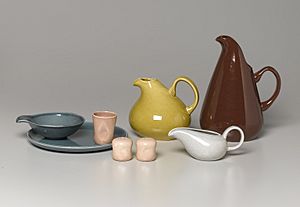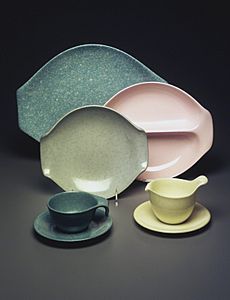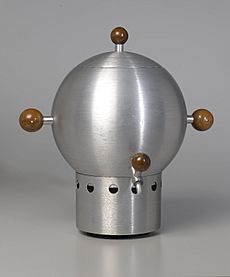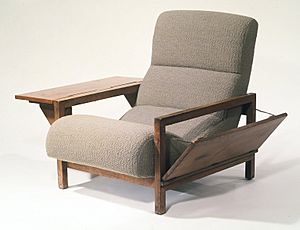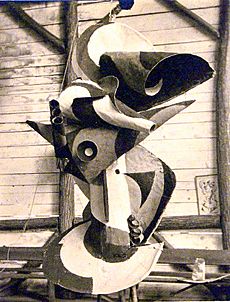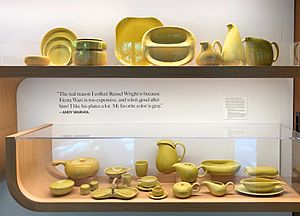Russel Wright facts for kids
Quick facts for kids
Russel Wright
|
|
|---|---|

Russel Wright in his studio, "Dragon Rock", at his Manitoga home/studio in Garrison, New York, US
|
|
| Born | April 3, 1904 Lebanon, Ohio, US
|
| Died | December 21, 1976 (aged 72) |
| Nationality | American |
| Known for | Industrial design |
| Movement | American Modern |
| Spouse(s) | Mary Small Einstein (1927–1952; her death) |
Russel Wright (born April 3, 1904 – died December 21, 1976) was a famous American industrial designer. He helped make modern design popular for everyday homes. His best-selling dinnerware, furniture, and other items made homes look stylish and new. The Russel and Mary Wright Design Gallery at Manitoga shows how the "Wrights shaped modern American lifestyle."
Contents
Designing for Modern Homes
Russel Wright believed that the dining table was the heart of a home. He designed everything from plates to large furniture, and even landscapes. His goal was to create an easy and relaxed lifestyle for people. Through his popular housewares and furniture, he changed how many Americans lived in the mid-1900s.
In 1927, Wright married Mary Small Einstein. She was also a designer, sculptor, and businesswoman. They met during a fun summer in Woodstock, New York. Mary studied sculpture with Alexander Archipenko. Together, Mary and Russel started Wright Accessories. This business designed small items for the home. They made metal animals and serving dishes from spun aluminum.
The couple also wrote a popular book called Guide to Easier Living in 1950. This book taught people how to do less housework. It showed how good design and smart home management could give them more free time. Today, Russel Wright Studios still works to license and make his designs.
Dinnerware Designs
Wright is most famous for his colorful "American Modern" design. This was the most widely sold American ceramic dinnerware ever. It was made from 1939 to 1959 by Steubenville Pottery in Steubenville, Ohio. He also designed "American Modern" silverware around 1951.
Wright created popular wooden furniture, spun aluminum dining items, and fabrics. His simple, useful style helped ordinary Americans like Modernism in the 1930s, 1940s, and 1950s. His signature was the first to be used on products sold based on a certain lifestyle.
Wright also designed several popular lines of Melmac plastic dinnerware. His first Melmac line for homes was called "Residential." It was made by Northern Plastic Company in Boston starting in 1953. "Residential" won the Museum of Modern Art Good Design Award in 1953. It was very popular, selling over $4 million in 1957.
In 1959, Wright introduced his "Flair" Melmac dinnerware line. One "Flair" pattern, "Ming Lace," had real leaves from the Chinese jade orchid tree. These leaves were tinted and placed inside the clear plastic. Like his ceramic dinnerware, Wright first designed Melmac in solid colors. Later, he added patterns, often showing plants.
Furniture Designs
Wright designed many popular furniture lines for different companies. He did this from the early 1930s through the 1950s. His most famous line of "blonde" wooden furniture was made by the Conant-Ball company. This furniture was produced between 1935 and 1939. It had a special mark: "American Modern Built by Conant-Ball Co. Designed by Russel Wright."
Wright also worked with the Old Hickory Furniture Company. They created unique rustic furniture with Wright's modern style. This collection came out in 1942 and remained popular into the 1950s.
Russel Wright's Career Path
Russel first studied art with Frank Duveneck while in high school. He later went to Princeton University to study law, as his family had done. But he won awards for his sculptures there. This, along with his earlier studies at the Art Students League of New York, confirmed his love for art.
Wright left Princeton to work in theater in New York City. He quickly became a set designer for Norman Bel Geddes. He also worked with other famous theater people like George Cukor. His theater career ended in 1927. After that, he started his own design company. He made theatrical props and small decorative metal objects.
Even though he grew up in the Midwestern United States, he spent his whole career in New York. He hired other talented designers like Petra Cabot and Henry P. Glass for his growing design firm.
Russel Wright's Life
Russel Wright was born in Lebanon, Ohio. His family was very old and historic in America. His mother was directly related to two people who signed the United States Declaration of Independence. His father and grandfather were local judges. Both of his parents were Quakers.
Russel and Mary had one adopted daughter, Annie. When Mary died in 1952, Annie was only two years old. Russel raised Annie as a single parent. Annie Wright still manages her father's designs and products today through Russel Wright Studios.
Manitoga: His Home and Studio
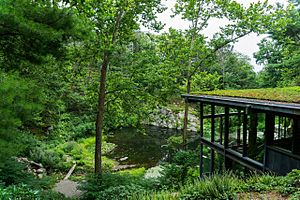
After his wife passed away, Russel Wright moved to his 75-acre (300,000 m2) estate called Manitoga in Garrison, New York. He built an eco-friendly Modernist home and studio there, called Dragon Rock. It was surrounded by beautiful woodland gardens. Dragon Rock is made of wood, stone, and glass. It is known as a very unique home.
Wright designed the entire property. He created eleven walking trails in the woods. He even filled in an old quarry and changed the path of a stream. The house displays furniture he designed or changed. It also has the Russel and Mary Wright Design Gallery. Here, his pottery and other home objects are shown.
Manitoga is listed on the National Register of Historic Places. It is also a U.S. Department of Interior designated National Historic Landmark. Manitoga is open to the public. The non-profit Russel Wright Design Center runs tours and hiking trails there.
Where to See His Work
Wright's designs are in many famous museums. You can find his work at the Metropolitan Museum of Art in New York. It's also at the Cooper Hewitt, Smithsonian Design Museum and the Museum of Modern Art in New York. The Brooklyn Museum and many other public collections also have his designs.


